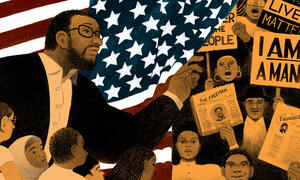article
352 Results
article
"These Guys Are Fun!"
School and community programs foster friendships across the generations
text
Informational
Untamed Border
This chapter depicts the violent relationship between Tejanos (Texas Mexicans) and Texas Rangers in the late 19th century and early 20th century, culminating in the notion that “though a Tejano spent his life under the watchful eyes of whites, he was beneath all notice in death.”
February 8, 2017
text
Literature
March With Me
Letitia and Mae join children leaving school to march in Birmingham, Alabama. Disappointed that they were not arrested while picketing Woolworth’s, they feel reassured by Rev. Bevel, who tells them they made a great contribution to the movement.
October 30, 2014
article
Columbine Timeline
Spring & Summer 1999 April 20 Columbine High School students Eric Harris and Dylan Klebold shoot and kill 12 students and one teacher before turning the guns on themselves. Twenty-three are injured. The students killed
text
Informational
The Silencing of Mary Dyer
In this chapter, Carnes details oppression experienced by the early New England colonists. In particular, he chronicles Mary Dyer’s path from a once uncomfortably conforming Puritan to an outspoken Quaker unshaken by threats, banishment and even death.
January 23, 2017
page
Music Reconstructed: Adia Victoria and the Landscape of the Blues
Installment 3 When we consider the trauma of white supremacy during the Jim Crow era—what writer Ralph Ellison describes as “the brutal experience”—it’s important to understand the resilience and joy that sustained Black
April 12, 2022
article
True Pictures
The Pinkney's offer children new ways to see -- and read about -- themselves.
text
Informational
In the City of Brotherly Love
“The Irish and the English share a long legacy of conflict.” And this conflict extended across the Atlantic Ocean to the New World as a wave of Catholic immigrants arrived in the United States in the 1820s.
May 22, 2017
article
A Call for Anti-Bias Education

To develop the next generation of civic leaders, educate children early and in age-appropriate ways about their identities and key concepts about race.
